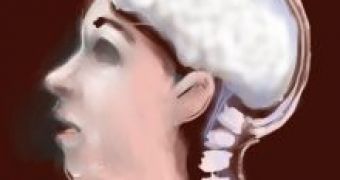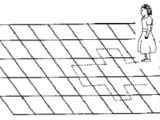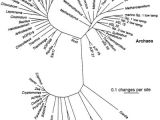"Consider the book Don Quixote: a stack of paper with ink marks on the pages, but you could put it on a CD or a tape and turn it into sound waves for blind people. No matter what medium it's in, it's always the same book, the same information. This is true of everything else in the cultural realm. It can be recorded in many different media, but it's the same [information] no matter what medium it's recorded in," wrote George C. Williams, the famous evolutionary biologist.
And information is not limited to the cultural domain. Everything in biology involves the concept: "The gene is a package of information, not an object. The pattern of base pairs in a DNA molecule specifies the gene. But the DNA molecule is the medium, it's not the message. Maintaining this distinction between the medium and the message is absolutely indispensable to clarity of thought about evolution," Williams wrote. (Read his essay.)
When you eat and breathe, new matter (atoms and molecules) enters your body and gets incorporated into it, according to a clear plan. This plan is the information stored in the DNA. When you reproduce, your offspring resembles you in various ways, because he or she gets something from you: information.
Thus, this information "thing" is independent of the actual matter, from the actual "storage facility". The software is different from the hard-disk that holds it. So, one has to wonder what exactly is this "information"?
The solution to this dilemma is similar to the answer to the question "What is a number?". (Read article.) In fact, it is a straightforward generalization of that idea, because a number is nothing else but a special case of information (saying for example "I have five fingers" lays down some information about your hand).
The solution is this: information is not a thing in itself (an "abstract thing"), but a relation between two things - the thing that "holds" the information and the interpreter. The book Don Quixote is "stored" in those ink marks only because one knows how to interpret them. Our way of speaking implies that one extracts the information from the book's pages, but information actually exists only while you are reading and understanding the book. If nobody reads and understands the book, the information is not there - only the material support is there.
So, we can say that many of the misunderstandings surrounding the concept of information arise from the fact that people mistake an act of creation with a discovery. Information is created when the book is read, but people think they discover the information already present in the book. We are so modest!
One can further explore this avenue by noting that the information one gets from a book, newspaper article etc. always differs in certain ways from the information somebody else gets from the same book, news paper article etc. Two people rarely understand the same thing in exactly the same way. The author is rarely understood by the readers in exactly the way he wants. Similarly, the DNA information is not perfectly decoded into proteins by the cellular mechanisms - which is why aging occurs. The information "contained" in the DNA is also a relation between the DNA and the cellular mechanism that makes use of the DNA. (For how that happens see article.)
Once we acknowledge that the information is a relation and not a thing, we can start wondering about the nature of this relation. After all, not any relation between two things is information. For instance the gravitational relation between the Sun and the Earth is not informational. Such issues are discussed at some length by Juan G. Roederer in an interesting essay he has published in the open-access journal Entropy.
The main feature of the informational relation is that it is intentional rather than causal. In other words it is oriented towards some goal - it increases the probability that something would happen in the future (something which otherwise would have had a low probability of occurrence).
For example, you find an article very informative if - on one hand - it changes the way you behave and - on the other hand - it is very unlikely you would have come up with such ideas yourself. Similarly, a genome contains a lot of information if, on one hand, it exists in a context of proteins that leads to the development of some creature (and not in a lab fridge where it stays frozen for decades) and, on the other hand, if that end structure (the living creature) is very unlikely to have appeared in the absence of the genome (thus, human DNA contains more information than virus DNA, because a human is a more improbable creature than a virus).
One can understand the distinction between intentionality and causality by taking into consideration whether the "guiding hand" of the process is located in the past or in the future - whether it is a cause or a goal.
The random walk
The basic models for causality are the random walk and the constrained random walk. An easy way to understand random walking is to do a simple experiment suggested by University of Wisconsin's professor Clint Sprott:
"Go out to a large open field and mark a spot on the ground. Take with you a coin like a nickel or a quarter. Stand on the spot and flip the coin. If the coin comes up heads, turn to the right and take a large step. If the coin comes up Tails, turn to the left and take a large step. Keep doing this many times and see where you end up.
If you flip the coin 25 times you will probably be about five steps away from where you started. This is because five times five equals 25. How far would you expect to be if you flipped the coin 100 times? A random walk is not a very fast way to get anywhere!
When you try this, you will notice that sometimes you go much farther than you expect and sometimes you end up very close to where you started. But if you repeat it many times or get several of your friends to do it with you with coins of their own, the average distance should come out as expected. In science we can often predict what will happen on the average even when the process is random."
This type of motion with its basic rule of how to get from the present state to the next one has an open-ended future. Because the "rule" is actually randomness: you lose any memory of the past - you cannot deduce where you were, say, five steps ago by observing where you are now. Thus, randomness erases the information about the past. It is worth noting that this is how our actual memory works too - we don't recall something because we have stored that information somewhere in the brain, but because our brain deduces from its present state how the past must have been. (Read article.)
Some things in nature are just random walks. The typical example is a rarefied gas (called an ideal gas). In an ideal gas, each molecule is random walking through space and, because the gas is rare, no molecule interacts with any other molecule. (This idealization gives a surprisingly exact description of real gases.)
The constrained random walk is what we usually encounter in all physical processes. For example, in a liquid, the molecules are so closely packed that they interact with each other and thus, they are no longer free to random walk. Due to the constraints, the memory of the past is retained to a certain degree. (Thus order appears from disorder if some conditions are met.)
It is interesting to note that - if you have many things random walking (with or without some constraints) starting from the same spot and dividing from time to time - you get a structure that is identical to the "tree of life" (see the image - credit: NR Pace, Science 1997). This is direct proof that the evolution of life is not guided by some intelligence, but it is a blind causal process (a random walk constrained by natural selection). The hallmark of intentional intelligence is the inverse random walk, which is not how the tree of life looks like.
The inverse random walk
A basic model for intentional behavior is this: Imagine a frozen lake with a waterhole somewhere in the middle (and protected by a small hut). It is winter and the wind is blowing fiercely and, from time to time, it changes direction at random. In spite of the wind, some dedicated fishermen sometimes go to the waterhole. They come from various directions and are pushed at random by the wind, but from wherever they come and, however they are pushed by the wind, they gradually head towards their destination in the middle of the lake.
The point is this: if you filmed them and reversed the movie they would look like random walking from the waterhole. Similarly, if you film a causal process (a river flowing, an egg breaking etc.) and reverse it, it looks like it is heading for some goal.
Thus, simply by watching the behavior of something, you can detect whether or not it has intelligence, i.e. whether or not it is capable of processing information. You don't need to "get inside its head", it is sufficient to watch what it does. If the thing's behavior exhibits an inverse random walk, i.e. it is intentional behavior, than the thing must be intelligent. Otherwise it is just causal.
The thermodynamic perspective
One can wonder how intentionality appears from causality. In his discussion of causality and intentionality, Roederer observes an interesting and very revelatory fact: if the behavior of something is guided by information, than its energy supply comes from a different source than the information itself. In other words, informational relations (between A and B) happen in open systems (there's always some additional C involved).
For example, flies fly around a light bulb more or less in the same way as the electrons fly around an atomic nucleus. Both motions include an element of randomness and are attracted by the central thing (the light bulb or the atomic nucleus). But the energy that keeps the electrons around the nucleus comes from the nucleus (electromagnetic energy - i.e. light), while the energy that keeps the flies around the light bulb has nothing to do with the light coming from the light bulb. All that flies get from the light bulb is information (and no energy); all that electrons get from the atomic nucleus is energy (and no information).
When I say that the flies "get information" from the light bulb, I mean it in exactly the same sense as I have described it above: The light coming from the light bulb interacts with the flies and the result is that the flies move in a certain way that otherwise would have been very improbable - this is why we can say that the flies have a certain goal (they like something about the light bulb). Their motion is an inverse random walk, not a constrained random walk. This becomes evident only when you observe that the flies-light-bulb system is an open system that exists only as long as there is an energy input from a different source (in this case the flies' digestive system). On the other hand, the atom retains its structure without any energy input.
The flies can fly, because certain chemical processes happen inside them - they get their energy from digesting the food. In the basement of their intentional motion there are causal processes: the emission and perception of light are physical processes and the processes that keep the flies in the air are physical processes. Thus, in the same way as causal order appears under certain conditions when random processes constrain each other, the intentional order appears under some further conditions when causal processes constrain each other as well. (More on this here.) In other words, the inverse random walk appears from the interaction of multiple constrained random walks.
An example
It is interesting to actually see this idea put in practice, so more details become evident. One of the simplest intentional structures is the volvox. I will describe here an idealized version of the creature which is actually more complicated than the real one - the real volvox (described in this article) uses some of the unusual properties of water so it is more difficult to understand. (The unsusual properties of water make this idealized volvox here unnecessarily complex - but easier to describe.)
The idealized volvox is a sphere that has in each "point" (a small patch on its surface) both a detector and a flagellum. The detector is a cell that detects a certain substance (a nutrient needed by the volvox in order to survive) and that it is connected via a neuron to a flagellum. Each detector is connected to the diametrical flagellum (in the image you have to consider that all the detectors are connected to a flagellum, I haven't drawn all the connections because the image would have been too busy). The entire structure is floating around in water.
The point is that each time a detector is activated by a nutrient, the opposite flagellum starts to wiggle, pushing the entire volvox in that direction. If the volvox finds itself in a gradient of nutrients (there are more nutrients in a certain direction, and gradually less in other directions) various flagella will wiggle more or less often (each will wiggle with the same frequency as the detection frequency of the opposite detector).
Thus, the entire structure will move toward the most "juicy" region in the water, where there is a maximum of nutrients. This volvox is a gradient detector that wants to reach the most "juicy" spot.
This is a very simple example of a structure made of strictly causal components, that, considered as a whole, has a desire. This is an example of how an intention is born out of simpler causal components connected in a certain way. The volvox as a whole moves like the fishermen in the story above (or, if you like, the fishermen move like the volvox) - it's motion is described by an inverse random walk. (The real volvox manages to do the same job without any detectors! This has obviously baffled scientists for some time. The story of the real volvox is very important for evolutionary biology because it marks the transition from unicellular life to multicellular beings.)
Another way of putting it
A fly (or a fisherman) is a much more complex structure than a volvox, because it has many more desires. What is interesting about something like a fly (or even a volvox) is that in a certain sense the fly is not just a "slave" of the causal processes that happen inside it. We can say that the causal processes are used by the fly as means of reaching its goals - the fly makes use of the light coming from the light bulb. The flies are the "masters" of the light coming from the light bulb, while the electrons are the "slaves" of the light (the virtual photons that make up the electromagnetic force) coming from the atomic nucleus. When this transition from "slave" to "master" happens, informational processes are born.
And this always happens when we're dealing with informational relations. Information is always used for something. For example, the information you get from a book or article depends on your interests, when you understand what the book says you are actually using the book for some purpose. You can't "just understand" without having the slightest interest in the subject. And when an author puts some information in a book or article he or she aims at having a certain effect on the readers.
You can now ponder more efficiently over the difference between information and miss-information.

 14 DAY TRIAL //
14 DAY TRIAL // 



